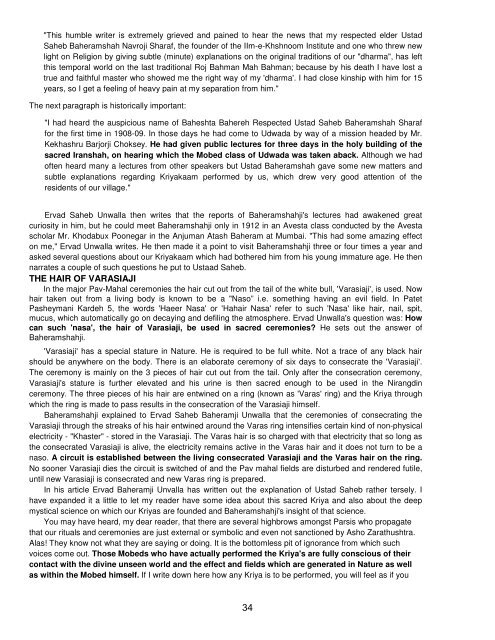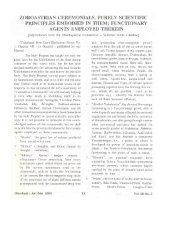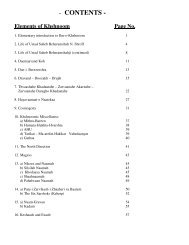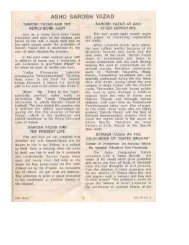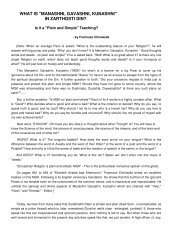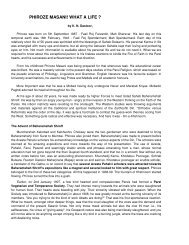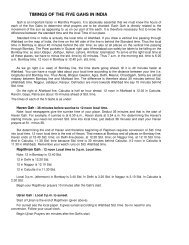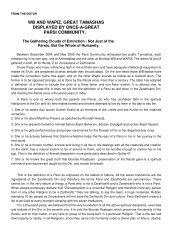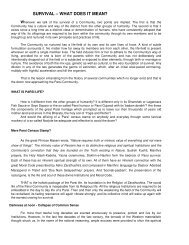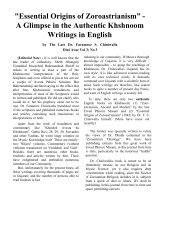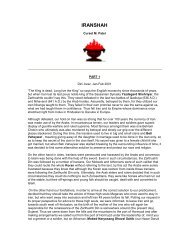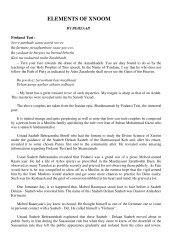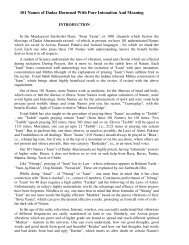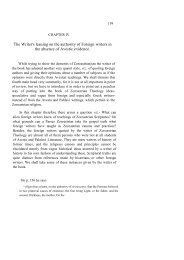Ilm-e-Khshnoom - Traditional Zoroastrianism: Tenets of the Religion
Ilm-e-Khshnoom - Traditional Zoroastrianism: Tenets of the Religion
Ilm-e-Khshnoom - Traditional Zoroastrianism: Tenets of the Religion
You also want an ePaper? Increase the reach of your titles
YUMPU automatically turns print PDFs into web optimized ePapers that Google loves.
"This humble writer is extremely grieved and pained to hear <strong>the</strong> news that my respected elder Ustad<br />
Saheb Baheramshah Navroji Sharaf, <strong>the</strong> founder <strong>of</strong> <strong>the</strong> IIm-e-<strong>Khshnoom</strong> Institute and one who threw new<br />
light on <strong>Religion</strong> by giving subtle (minute) explanations on <strong>the</strong> original traditions <strong>of</strong> our "dharma", has left<br />
this temporal world on <strong>the</strong> last traditional Roj Bahman Mah Bahman; because by his death I have lost a<br />
true and faithful master who showed me <strong>the</strong> right way <strong>of</strong> my 'dharma'. I had close kinship with him for 15<br />
years, so I get a feeling <strong>of</strong> heavy pain at my separation from him."<br />
The next paragraph is historically important:<br />
"I had heard <strong>the</strong> auspicious name <strong>of</strong> Baheshta Bahereh Respected Ustad Saheb Baheramshah Sharaf<br />
for <strong>the</strong> first time in 1908-09. In those days he had come to Udwada by way <strong>of</strong> a mission headed by Mr.<br />
Kekhashru Barjorji Choksey. He had given public lectures for three days in <strong>the</strong> holy building <strong>of</strong> <strong>the</strong><br />
sacred Iranshah, on hearing which <strong>the</strong> Mobed class <strong>of</strong> Udwada was taken aback. Although we had<br />
<strong>of</strong>ten heard many a lectures from o<strong>the</strong>r speakers but Ustad Baheramshah gave some new matters and<br />
subtle explanations regarding Kriyakaam performed by us, which drew very good attention <strong>of</strong> <strong>the</strong><br />
residents <strong>of</strong> our village."<br />
Ervad Saheb Unwalla <strong>the</strong>n writes that <strong>the</strong> reports <strong>of</strong> Baheramshahji's lectures had awakened great<br />
curiosity in him, but he could meet Baheramshahji only in 1912 in an Avesta class conducted by <strong>the</strong> Avesta<br />
scholar Mr. Khodabux Poonegar in <strong>the</strong> Anjuman Atash Baheram at Mumbai. "This had some amazing effect<br />
on me," Ervad Unwalla writes. He <strong>the</strong>n made it a point to visit Baheramshahji three or four times a year and<br />
asked several questions about our Kriyakaam which had bo<strong>the</strong>red him from his young immature age. He <strong>the</strong>n<br />
narrates a couple <strong>of</strong> such questions he put to Ustaad Saheb.<br />
THE HAIR OF VARASIAJI<br />
In <strong>the</strong> major Pav-Mahal ceremonies <strong>the</strong> hair cut out from <strong>the</strong> tail <strong>of</strong> <strong>the</strong> white bull, 'Varasiaji', is used. Now<br />
hair taken out from a living body is known to be a "Naso” i.e. something having an evil field. In Patet<br />
Pasheymani Kardeh 5, <strong>the</strong> words 'Haeer Nasa' or 'Hahair Nasa' refer to such 'Nasa' like hair, nail, spit,<br />
mucus, which automatically go on decaying and defiling <strong>the</strong> atmosphere. Ervad Unwalla's question was: How<br />
can such 'nasa', <strong>the</strong> hair <strong>of</strong> Varasiaji, be used in sacred ceremonies? He sets out <strong>the</strong> answer <strong>of</strong><br />
Baheramshahji.<br />
'Varasiaji' has a special stature in Nature. He is required to be full white. Not a trace <strong>of</strong> any black hair<br />
should be anywhere on <strong>the</strong> body. There is an elaborate ceremony <strong>of</strong> six days to consecrate <strong>the</strong> 'Varasiaji'.<br />
The ceremony is mainly on <strong>the</strong> 3 pieces <strong>of</strong> hair cut out from <strong>the</strong> tail. Only after <strong>the</strong> consecration ceremony,<br />
Varasiaji's stature is fur<strong>the</strong>r elevated and his urine is <strong>the</strong>n sacred enough to be used in <strong>the</strong> Nirangdin<br />
ceremony. The three pieces <strong>of</strong> his hair are entwined on a ring (known as 'Varas' ring) and <strong>the</strong> Kriya through<br />
which <strong>the</strong> ring is made to pass results in <strong>the</strong> consecration <strong>of</strong> <strong>the</strong> Varasiaji himself.<br />
Baheramshahji explained to Ervad Saheb Baheramji Unwalla that <strong>the</strong> ceremonies <strong>of</strong> consecrating <strong>the</strong><br />
Varasiaji through <strong>the</strong> streaks <strong>of</strong> his hair entwined around <strong>the</strong> Varas ring intensifies certain kind <strong>of</strong> non-physical<br />
electricity - "Khaster" - stored in <strong>the</strong> Varasiaji. The Varas hair is so charged with that electricity that so long as<br />
<strong>the</strong> consecrated Varasiaji is alive, <strong>the</strong> electricity remains active in <strong>the</strong> Varas hair and it does not turn to be a<br />
naso. A circuit is established between <strong>the</strong> living consecrated Varasiaji and <strong>the</strong> Varas hair on <strong>the</strong> ring.<br />
No sooner Varasiaji dies <strong>the</strong> circuit is switched <strong>of</strong> and <strong>the</strong> Pav mahal fields are disturbed and rendered futile,<br />
until new Varasiaji is consecrated and new Varas ring is prepared.<br />
In his article Ervad Baheramji Unvalla has written out <strong>the</strong> explanation <strong>of</strong> Ustad Saheb ra<strong>the</strong>r tersely. I<br />
have expanded it a little to let my reader have some idea about this sacred Kriya and also about <strong>the</strong> deep<br />
mystical science on which our Kriyas are founded and Baheramshahji's insight <strong>of</strong> that science.<br />
You may have heard, my dear reader, that <strong>the</strong>re are several highbrows amongst Parsis who propagate<br />
that our rituals and ceremonies are just external or symbolic and even not sanctioned by Asho Zarathushtra.<br />
Alas! They know not what <strong>the</strong>y are saying or doing. It is <strong>the</strong> bottomless pit <strong>of</strong> ignorance from which such<br />
voices come out. Those Mobeds who have actually performed <strong>the</strong> Kriya's are fully conscious <strong>of</strong> <strong>the</strong>ir<br />
contact with <strong>the</strong> divine unseen world and <strong>the</strong> effect and fields which are generated in Nature as well<br />
as within <strong>the</strong> Mobed himself. If I write down here how any Kriya is to be performed, you will feel as if you<br />
34


